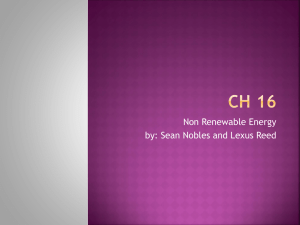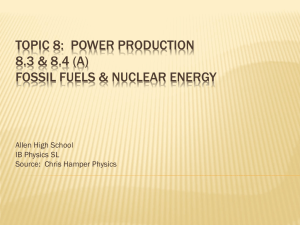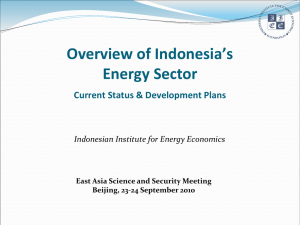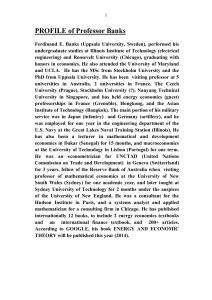Introduction to Nuclear Energy
advertisement
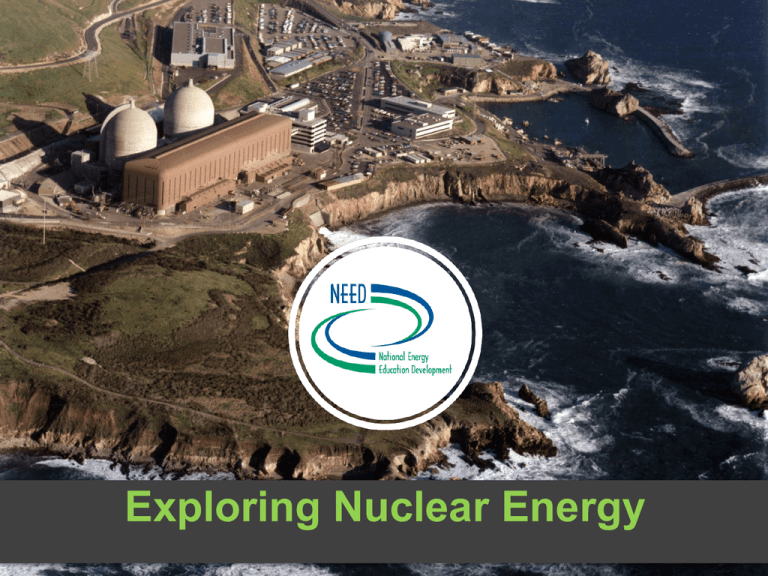
Exploring Nuclear Energy Nuclear Fusion and Fission Nuclear Fusion • Small nuclei into large • Immense temperature and pressure • Core of stars Nuclear Fission • Large nuclei into small • Critical mass to sustain • Two isotopes we use U 235 Pu 239 Iron is the “dead end” of both fusion and fission – it is the lowest energy nucleus and cannot be split or fused. Global Total Primary Energy Supply, 2012 Nuclear provides about 5% of total energy and 10.8% of global electricity generation. Natural Gas 21.27% Petroleum 31.45% Data: International Energy Agency Coal 29.01% Nuclear 4.80% Hydropower 2.36% Geothermal, Biofuels Solar, etc. and Waste 1.06% 10.05% Top 10 Nuclear Generating Countries, 2013 800 Billion kiloWatt-hours 700 600 500 400 300 200 100 0 Data: Energy Information Administration U.S. Primary Energy Consumption Source and Sector, 2012 (Quadrillion Btu) The NEED Project Data: Energy Information Administration U.S. Electricity Production 2012 Petroleum 0.57% Nuclear 19.01% Hydroelectric 6.70% Geothermal 0.38% Solar 0.11% Other 0.63% Biomass 1.42% Wind 3.48% Natural Gas 30.29% Data provided by US EIA Net Generation by Energy Source The NEED Project Coal 37.40% U.S. Electricity Flow U.S. Electricity Flow, 2012 (Quadrillion Btu) Data: Energy Information Administration The NEED Project Nuclear Energy Production Percent of Electricity Generated by Nuclear Power • VT – 70.0% • MN – 20.9% • SC – 57.2% • MS – 20.5% • NH – 55.2% • AR – 19.7% • NJ – 51.5% • NE – 18.5% • CT – 48.2% • WI – 17.8% • IL – 47.9% • LA – 16.7% • MD – 40.2% • KS – 14.7% • VA – 38.0% • MA – 12.8% • TN – 36.2% • FL – 12.1% • PA – 34.6% • OH – 11.8% • NY – 33.1% • IA – 9.4% • NC – 32.2% • MO – 9.1% • AZ – 28.5% • CA – 9.0% • MI – 27.6% • TX – 8.8% • GA – 27.2% • WA – 7.5% • AL – 27.1% Data: Nuclear Energy Institute Anatomy of a Nuclear Power Plant Source: NRC Anatomy of a Nuclear Power Plant Source: NRC Advantages of Nuclear Power Clean Plentiful Supply High energy content in uranium • Small fuel pellet • Can provide base load power • Energy savings in transportation Operating cost is low after construction The NEED Project Drawbacks to Using Nuclear Power Initial construction costs Radioactive waste byproduct Storage Natural disasters Public perception The NEED Project New Nuclear Technologies Modular, small-scale reactors Breeder reactors http://www.energy.gov/science-innovation/energysources/nuclear Image courtesy of Department of Energy The NEED Project Food for thought… Of the 15 methods (wedges) proposed by a Princeton University study to stabilize Carbon Dioxide emissions, 13 of them relate energy use. Implementation of any 7 would accomplish the goal of stabilizing emissions. 1. Efficient vehicles 2. Reduced use of vehicles 3. Efficient buildings 4. Efficient coal power plants 5. Gas instead of coal power plants 6. Capture CO2 at base load power plant 7. Nuclear power for coal power 8. Wind power for coal power 9. Photovoltaic power for coal power 10. Capture CO2 at H2 plant 11. Capture CO2 at coal-to-synfuels plant 12. Wind H2 in fuel-cell car for gasoline in hybrid car 13. Biomass fuel for fossil fuel The NEED Project For More Information The NEED Project www.need.org info@need.org 1-800-875-5029 Energy Information Administration U.S. Department of Energy www.eia.gov The NEED Project



![The Politics of Protest [week 3]](http://s2.studylib.net/store/data/005229111_1-9491ac8e8d24cc184a2c9020ba192c97-300x300.png)

